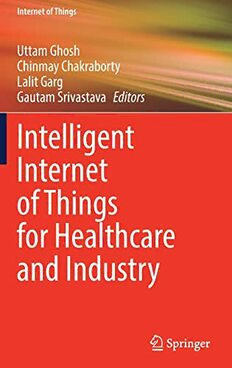
Intelligent Internet of Things for Healthcare and Industry PDF
Preview Intelligent Internet of Things for Healthcare and Industry
Internet of Things Uttam Ghosh Chinmay Chakraborty Lalit Garg Gautam Srivastava Editors Intelligent Internet of Things for Healthcare and Industry Internet of Things Technology, Communications and Computing SeriesEditors GiancarloFortino,Rende(CS),Italy AntonioLiotta,EdinburghNapierUniversity,SchoolofComputing, Edinburgh,UK The series Internet of Things - Technologies, Communications and Computing publishesnewdevelopmentsandadvancesinthevariousareasofthedifferentfacets oftheInternetofThings.Theintentistocovertechnology(smartdevices,wireless sensors, systems), communications (networks and protocols) and computing (the- ory, middleware and applications) of the Internet of Things, as embedded in the fieldsofengineering,computerscience,lifesciences,aswellasthemethodologies behind them. The series contains monographs, lecture notes and edited volumes in the Internet of Things research and development area, spanning the areas of wireless sensor networks, autonomic networking, network protocol, agent-based computing,artificialintelligence,selforganizingsystems,multi-sensordatafusion, smartobjects,andhybridintelligentsystems. **Indexing:InternetofThingsiscoveredbyScopusandEi-Compendex** Moreinformationaboutthisseriesathttps://link.springer.com/bookseries/11636 Uttam Ghosh • Chinmay Chakraborty • Lalit Garg Gautam Srivastava Editors Intelligent Internet of Things for Healthcare and Industry Editors UttamGhosh ChinmayChakraborty VanderbiltUniversity Electronics&CommunicationEngineering Nashville,TN,USA BirlaInstituteofTechnology Jharkhand,India LalitGarg GautamSrivastava InformationandCommunication MathematicsandComputerScience Technology BrandonUniversity UniversityofMalta Brandon,MB,Canada Msida,Malta ISSN2199-1073 ISSN2199-1081 (electronic) InternetofThings ISBN978-3-030-81472-4 ISBN978-3-030-81473-1 (eBook) https://doi.org/10.1007/978-3-030-81473-1 ©TheEditor(s)(ifapplicable)andTheAuthor(s),underexclusivelicensetoSpringerNatureSwitzerland AG2022 Thisworkissubjecttocopyright.AllrightsaresolelyandexclusivelylicensedbythePublisher,whether thewholeorpartofthematerialisconcerned,specificallytherightsoftranslation,reprinting,reuse ofillustrations,recitation,broadcasting,reproductiononmicrofilmsorinanyotherphysicalway,and transmissionorinformationstorageandretrieval,electronicadaptation,computersoftware,orbysimilar ordissimilarmethodologynowknownorhereafterdeveloped. Theuseofgeneraldescriptivenames,registerednames,trademarks,servicemarks,etc.inthispublication doesnotimply,evenintheabsenceofaspecificstatement,thatsuchnamesareexemptfromtherelevant protectivelawsandregulationsandthereforefreeforgeneraluse. Thepublisher,theauthorsandtheeditorsaresafetoassumethattheadviceandinformationinthisbook arebelievedtobetrueandaccurateatthedateofpublication.Neitherthepublishernortheauthorsor theeditorsgiveawarranty,expressedorimplied,withrespecttothematerialcontainedhereinorforany errorsoromissionsthatmayhavebeenmade.Thepublisherremainsneutralwithregardtojurisdictional claimsinpublishedmapsandinstitutionalaffiliations. ThisSpringerimprintispublishedbytheregisteredcompanySpringerNatureSwitzerlandAG Theregisteredcompanyaddressis:Gewerbestrasse11,6330Cham,Switzerland Tomyfamily.UttamGhosh ToArjunandKrishna.GautamSrivastava Preface MotivationsforThis Book The Internet of Things (IoT) is made up of software components and physical objectsthataredeeplyintertwined,eachoperatingondifferentspatialandtemporal scales, exhibiting multiple behavioral modalities and interacting with each other and with the users. They can interact directly with data and access services using a myriad of ways that change with their context of use. Smart grids, global environmental and disaster monitoring systems, medical and homeland security systemsaswellasautonomoustransportation,andautomaticpilotavionicsarethe mainapplicationsofIoT. Data analytics has a significant role to play in the growth and success of IoT applicationstowardexpertprocessingofhugeprocess-leveldata.Theutilizationof data analytics shall, therefore, be promoted in the area of IoT to gain improved revenues, competitive gain, and customer engagement. In recent years, machine learning approaches have emerged as powerful computational models and have shown significant success to deal with a massive amount of data in unsupervised settings. The emerging technologies of cyber-physical systems, wearable devices, cloudcomputing,anddataanalyticsofferthepotentialofacquiringandprocessing a tremendous amount of data from the physical world. Promising computing paradigmsandadvancedtechnologies(e.g.,smarthomeorcity)relatingtocontext awareness systems, activity recognition, distributed smart sensing, heterogeneous big data analytics, and machine learning have been increasingly developed and integrated into IoT to make it a reality. Learning analytics provides new impulses forthedevelopmentandapplicationofcyber-physicalsystems. Intelligent Internet of Things for Healthcare and Industry focuses on emerging trends, strategies, and applications of IoT in both healthcare and industry from a data analytics perspective. IoT systems will continuously generate massive data that requires big data techniques to process and help to improve system security, efficiency, and scalability. Data analytics are relevant for healthcare as well as industry to meet many technical challenges and issues that need to be addressed vii viii Preface to realize this potential. The advanced healthcare systems have to be upgraded withnewcapabilitiessuchasdataanalytics,machinelearning,intelligentdecision- making,andmoreprofessionalservices.IoThelpstodesignanddevelopintelligent medicalandindustrysolutionsassistedbydataanalyticsandmachinelearning. ContentsofThis Book Intelligent Internet of Things for Healthcare and Industry is made up of sev- eral state-of-the-art chapters from both scientists and practitioners working in IoT, healthcare, and AI. It aspires to provide a relevant reference for students, researchers, engineers, and professionals working in this area or those interested in grasping its diverse facets and exploring the latest advances in the field. More specifically,thebookcontains17chapters,splitintotwomainparts.PartIfocuses onIoTinhealthcare,whilePartIIisabouttheIntelligentIoTintheindustry.Chapter 1 examines the effectiveness of machine and deep learning on IoT healthcare devices.Chapter2featuresanin-depthlookintonetworkprotocolsontheInternet ofHealthThings(IoHT).Chapter3examinesaffectivecomputingine-healthusing remote IoT. Chapter 4 investigates the COVID-19 pandemic and ways IoT can helpfightitsramifications.Chapter5looksatpatienthealthmonitoringusingIoT sensors.InChap.6,blockchainisimplementedforsecuresmarthealthcaresystems. Chapter 7 examines the impact of computation intelligence on the healthcare systems emphasizing bioinformatics and the Internet of Medical Things. A very in-depth survey of security and privacy in the Internet of Medical Things is given in Chap. 8. Chapter 9 presents an exploration into wearable sensor technology in healthcare. In Chap. 10, diabetes prediction is examined using a fog-based infrastructure. A comprehensive analysis of IoT sustainability in a post-COVID era is given in Chap. 11. Diagnosis of autism is investigated in Chap. 12 using optimization algorithms. Moving away from healthcare in the second part of the book,Chap.13divesintomachinelearningandfogcomputingareasforsmartcities. In Chap. 14, quality of service and green computing is investigated for industry. Chapter15looksatprivacyissuesforsmartIoTnetworksinindustry.InChap.16, Industry4.0issurveyedintheautomotivefield.Toconclude,Chap.17implements smartsecurityforindustrialapplications. Acknowledgments We want to take this opportunity and express our thanks to the contributors to this volume and the reviewers for their great efforts in reviewing and providing interesting feedback to the authors of the chapters. The editors would like to thankDr.GiancarloFortino(Springer,SeriesEditor),Dr.AntonioLiotta(Springer, Series Editor), and Ms. Cynthya Pushparaj (Springer Project Coordinator) for the Preface ix editorial assistance and support to produce this important scientific work. Without thiscollectiveeffort,thisbookcouldnothavebeencompleted. Overall, Intelligent Internet of Things for Healthcare and Industry aims at promoting and facilitating exchanges of research knowledge and findings across differentdisciplines. Brandon,MB,Canada GautamSrivastava Msida,Malta LalitGarg Jharkhand,India ChinmayChakraborty Nashville,TN,USA UttamGhosh Contents EffectivenessofMachineandDeepLearninginIOT-Enabled DevicesforHealthcareSystem.................................................. 1 YogeshKumarandRuchiSingla NetworkProtocolsfortheInternetofHealthThings........................ 21 TrishaDasMouandGautamSrivastava Affective Computing for eHealth Using Low-Cost Remote InternetofThings-BasedEMGPlatform ..................................... 67 Žygintas Tamulis, Mindaugas Vasiljevas, Robertas Damaševicˇius, RytisMaskeliunas,andSanjayMisra ApplicationoftheInternetofThings(IoT)toFighttheCOVID-19 Pandemic.......................................................................... 83 Roseline Oluwaseun Ogundokun, Joseph Bamidele Awotunde, EmmanuelAbidemiAdeniyi,andSanjayMisra An Enhanced IoT-Based Array of Sensors for Monitoring Patients’Health .................................................................. 105 Modupe Odusami, Sanjay Misra, Olusola Abayomi-Alli, ShobayoOlamilekan,andChukwuebukaMoses A Secured Smart Healthcare Monitoring Systems Using BlockchainTechnology.......................................................... 127 Joseph Bamidele Awotunde, Chinmay Chakraborty, andSakinatOluwabukonlaFolorunso ComputationalIntelligenceinHealthcarewithSpecialEmphasis onBioinformaticsandInternetofMedicalThings........................... 145 Siddharth Banyal, Deepanjali Mehra, Amartya, Siddhant Banyal, DeepakKumarSharma,andUttamGhosh xi
